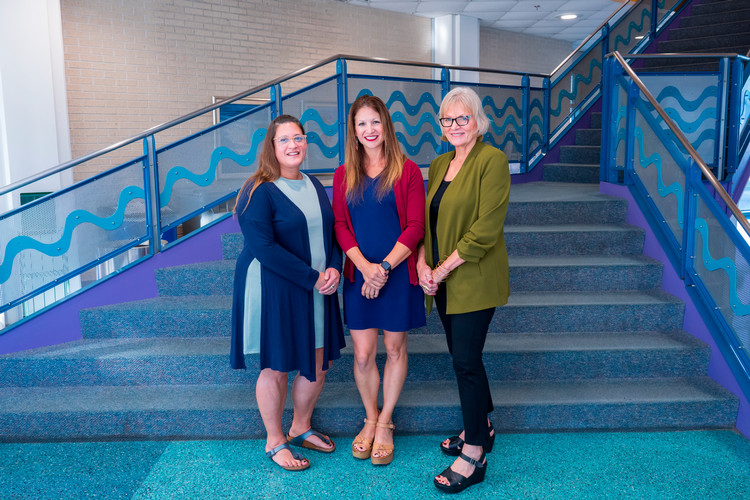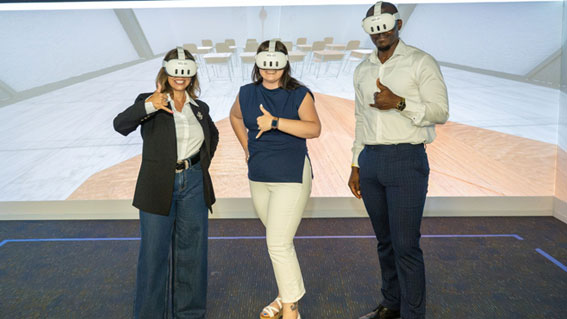Crime Scene Demo Challenges Students to Solve Dean ‘Murder’
Crime Scene Demo Challenges Students to Solve Dean ‘Murder’
The Criminal Justice Department at Texas A&M University-Corpus Christi hosted its third annual Crime Scene Demo on March 21 in the Faculty Center atrium. This year’s victim – Dr. Mark Hartlaub, Dean of the College of Liberal Arts – suffered an apparent stab wound and head injury – but as for how he perished? That was up to students to decipher.
CORPUS CHRISTI, Texas – They are items one might spy in a lost-and-found bin – a water bottle, a cellphone, a flip-flop, an old dictionary, a necklace, a hat – but how would perceptions of those items change if they were found instead surrounding a dead body?
The Criminal Justice Department at Texas A&M University-Corpus Christi hosted its third annual Crime Scene Demo on March 21 in the Faculty Center atrium. This year’s victim – Dr. Mark Hartlaub, Dean of the College of Liberal Arts – suffered an apparent stab wound and head injury – but as for how he perished? That was up to students to decipher.
Dr. Wendi Pollock, associate professor of criminal justice, is the mastermind behind the Crime Scene Demo. In the last three years, the event has not only grown in size but also in campus support.
“The first year we started with a fake body and a tiny student crowd,” said Pollock. “Then, last year, it grew quite a bit with President Quintanilla as our ‘victim,’ and we brought in the theatre department for makeup. This year, we have two crime scenes, one upstairs and one downstairs, dozens of students and faculty, along with support from the forensic science area, the theatre department, the University Police Department, and community experts including the Nueces County district attorney.”
Students were encouraged to investigate the crime scene and talk to a line-up of “suspects” to figure out who killed Hartlaub. Sleuthing skills include tasks like detailed observation, proper documentation, good communication, and a healthy dose of skepticism until facts could be verified.
“I'm interested to see if there was a scuffle before the fall, with maybe DNA under the fingernails of the assailant,” said Taylor Pilgreen, senior criminal justice major, after viewing the scene. “Also, I see a shoe, so we probably have shoe size, and there is a hair and chewed gum on the scene, so we can probably get DNA off those. There is also a receipt.”
After three years studying engineering, Pilgreen changed her major to criminal justice to fulfill her newfound goal of becoming a police officer.
“I really like problem-solving, and I always wanted to be a police officer but never thought I could,” she said. “But I decided to try it anyway because I didn’t want to have any regrets. Eventually, I’d like to be a homicide detective or work in the Special Victims Unit, and maybe even become a prosecutor.”
One of the presenters at the crime scene was Dr. Sharon Derrick, assistant professor and forensics coordinator, who talked about the role of both forensic anthropologists and medical examiner investigators. Later in the demo, Mark Gonzales, Nueces County District Attorney, along with members of his team, shared with students the importance of good detective work in building a strong case against a suspect, and also how the DA’s office welcome Island University interns into their shop.
“We certainly want our students to have field experience before they graduate,” said Pollock. “Many careers in criminal justice require extensive training and multiple degrees, so we want our students to love what they do and feel good about the effort they are putting forth. Also, particularly for students who chose to do police work, they are deciding that they are willing to risk their life for their job. Internships help clarify those decisions.”
Hartlaub’s “killer” was eventually identified as Dr. David Smith, assistant professor of political science. It turns out that if student investigators had asked Smith to raise his shirt sleeves, they would have noticed not only the scratches on his right hand but also a hand-shaped bruise on his upper forearm. While Smith could explain away the scratches as caused by his puppy, the bruise was harder to explain. Smith was also a well-known wearer of the type of shoes found at the scene.
“It all goes back to Dean Hartlaub’s belief that Star Trek is better than Star Wars,” said Smith. “We got into a scuffle, and I stabbed him good. I used ‘the force’ to push him over the railing, thus proving Star War is always better.”For more information
To learn more about the Criminal Justice Internship Program, visit http://cla.tamucc.edu/socialsciences/criminal_justice/criminal_justice_experience.html or email Dr. Sarah Scott at sarah.scott@tamucc.edu.







































































